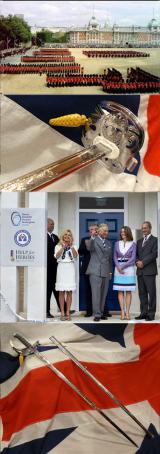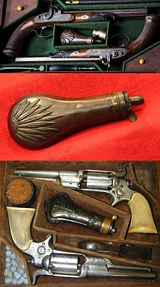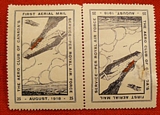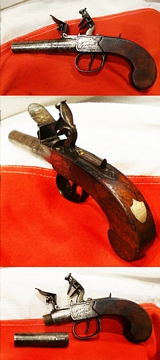A Very Attractive Pre WW1 German Military Beer Stein of the 46th Artillery
Souvenir of service for a WW1 volunteer.An Imperial Prussian stein for 4 Battery, Niedersachs Feld Artillery, Regt. 46, for the years 1904-1906. Lower Saxony Field Artillery Regiment No. 46. The recipient then volunteered back into the regiment and served in WW1. Superbly decorated. Transfer glazed with hand painted highlights with scenes of the field artillery in combat. Personally named 'in memory of my service' to the recipient 'Kanonier Bahrwald', and further named with every man's name from the regiment 47 names in all Souvenirs of service were purchased by reservists once there service was finished, in this case 1906. Steins seem to have been the most popular purchases. The period of popularity extended from the mid 1890s until the onset of World War I. Examples exist from the 1850s on, but were few in number and individually purchased items. Almost all early examples came from Bavarian units. Steins with wartime dates also exist but the demands of the war in terms of men and material effectively ended the manufacture of regimental steins as we know them.
Steins were ordered from military shops in the area around the garrison town or through the representatives of stein manufacturers. Normally ordered in the spring, they were delivered in early September, just prior to mustering out. The average cost approximated a month?s salary for a German private of that period. The base shows when lit internally the hidden factory 'watermark' in the porcelain. The base also has two old damage areas where the base has been penetrated and in other one area fixed see photo The lid's artillery cannon has the barrel lacking. The Regiment was part of the 20th Infantry Division in WW1. Their actions in WW1 were as follows Calendar of battles and engagements
20th Infantry Division (Western Front)
08.08.-08.16.1914 Conquest of Li?ge
23.08.-08.24.1914 Battle of Namur
29.08.-08.30.1914 Battle of St. Quentin
06.09.-09.09.1914 Battle of Petit-Morin
12.09.-09.13.1914 Fighting at Reims
13.09.1914-18.04.1915 Fighting at the Aisne
21.04.-04.30.1915 Transport to the east
20th Infantry Division (Eastern Front)
05.05.-05.23.1915 Pursuits after the Battle of Gorlice-Tarnow
16.05.-05.23.1915 Crossing over the San
24.05.-05.26.1915 Fight at Radymno and San
27.05.-04.06.1915 Fight at the bridgehead of Jaroslau
12.06.-06.15.1915 Breakthrough battle at Lubaczow
17.06.-06.22.1915 Battle of Lviv
22.06.-07.16.1915 Pursuit battles on the Galician-Polish border
16.07.-07.18.1915 Breakthrough Battle of Krasnostaw
19.07.-07.28.1915 Fighting after the breakthrough battle of Krasnostaw
29.07.-07.30.1915 Breakthrough Battle of Biskupice
31.07.-08.10.1915 Pursuit battles from Wieprz to Bug
12.09.-09.26.1915 Reserve of OH-L. and transport to the west
20th Infantry Division (Western Front)
27.09.-10.18.1915 Autumn Battle in Champagne
31.10.1915-16.05.1916 Fighting at the Aisne
03/10/1916 Storming of the mountain at La Ville aux Bois
18.05.-01.06.1916 Transport to the east
20th Infantry Division (Eastern Front)
14.06.-07.15.1916 Fights on Stochod
16.07.-07.27.1916 Fighting on the upper Styr-Stochod
28.07.-04.11.1916 Battle of Kovel
05.11.-11.18.1916 Positional fights on ob. Styr-Stochod
20.11.-11.25.1916 Transport to the west
20th Infantry Division (Western Front)
26.11.1916-05.01.1917 training
06.01.-02.03.1917 Fighting at the Aisne
10.04.-05.08.1917 Battle of the Aisne
15.05.-04.07.1917 Positional fights in Champagne
05.07.-07.12.1917 Transport to the east
20th Infantry Division (Eastern Front)
13.07.-07.22.1917 Fighting on the Lomnica near Kalusz
23.07.-07.30.1917 Pursuit battles in eastern Galicia
31.07.-02.08.1917 Fighting for Zbrucz, between Zbrucz and Sereth
03.08.-08.16.1917 Position fights between Zbrucz and Sereth
30.08.-08.31.1917 Position fights before Riga
01.09.-05.09.1917 Battle for Riga
09/02/1917 Fights on the Big Jail
09/03/1917 Wholesale Kangern
09/04/1917 Conquest of Bh. Hinzenberg
09/04/1917 Pursuit battles towards the Riga-Wenden road
06.09.-09.10.1917 Positional fighting north of the D?na
10.09.-09.20.1917 Transport to the west
20th Infantry Division (Western Front)
27.09.-10.10.1917 Battle in Flanders
20.11.1917-17.02.1918 Positional fights in the Artois
20.11.-11.29.1917 The tank battle at Cambrai
30.11.-07.12.1917 Attack Battle at Cambrai
18.02.-03.20.1918 Training and march to the "Great Battle of France"
21.03.-04.06.1918 Great battle in France
21.03.-03.23.1918 Breakthrough Battle Monchy-Cambrai
21.03.-03.23.1918 Fight for Morchies and Beugny
24.03.-03.25.1918 Battle of Bapaume
22.04.-05.25.1918 Fighting positions between Maas and Mosel: on the Maashohe at Lamorville-Spada and St. Mihiel
25.05.-06.25.1918 Reserve of OH-L. at Arlon
18.07.-07.26.1918 Defensive battle between Soissons and Reims
27.07.-03.08.1918 The mobile defensive battle between Marne and Vesle
03.08.-08.17.1918 Reserve Army Group German Kronprinz or Boehn
28.08.-02.09.1918 Battle of Monchy-Bapaume
06.09.-09.26.1918 Fighting in front of the Siegfried Front
27.09.-08.10.1918 Defensive battle between Cambrai and St. Quentin
03.11.-11.11.1918 Defensive battle on the Maas
03.11.-11.11.1918 Defensive battles between Maas and Beaumont
12.11.-12.23.1918 Clearance of the occupied territory and march home 12 inches high overall read more
255.00 GBP
A Grenadier Guards Officer's Sword From The Lanes Armoury Sold, and Raised £2,465 For The Queen Elizabeth Hospital Birmingham Charity, Photographed With H.M. King Charles formerly HRH P.O.W
Swords, over the eons, have been part of the journey of civilised mankind since the days of pre-history, before 1200 bc. And over 3200 years later, even ‘retired’ historic swords can be put to a fine use that they were certainly not entirely designed to perform.
We were absolutely delighted that a sword, from us, once sold at their special charity ball auction. The auction raised in total, £56,000, a most handsome sum.
Mike Hammond, the Chief Executive, wrote to us to say;
"We’ve already had hundreds more of people staying at the house since we opened our doors to military patients and their families, and the sword has helped in funding another 99 days of accommodation for the families".
The Queen Elizabeth Hospital in Birmingham is home to the Royal Centre for Defence Medicine, which treats UK military patients injured or wounded anywhere around the world.
The hospital charity built Fisher House, a home away from home for military patients and their families to stay whilst they are having medical treatment. You can see more about Fisher House at their website www.fisherhouseuk.org All donations will be most gratefully received.
A photo in the gallery is of HM King Charles when as HRH Prince Charles, opening Fisher House. read more
Price
on
Request
Original & Rare 19th Century Saxon M.1880 Faschinenmesser Pioneer Artillery Short Sword - Regimentally Marked
Royal Saxon Field Artillery Regiment No.71
Very scarce Saxon sidearm that was only made for one year 1880/1881, in very good condition. Ideal for the collector of rare German swords. No scabbard.
Brass pommel, ribbed grips affixed with three brass rivet insets, steel collar and cross guard, steel single fuller blade, Elmo style blade marked on the ricasso stamped on spine of blade Imperial stamp and Crown A regimentaly stamped
Coloured photograph of the Royal Saxon Field Artillery Regiment 78 in the gallery read more
675.00 GBP
The Lanes Armoury, Antiquarian & Specialist Book Dept. Many Thousands of Books in Stock, Most with a Military & Historical Flavour, Plus, Rare First Editions, Incunabula, Late Medieval Books or Illuminated Pages from Ancient Prayer Books
Just a tiny proportion can seen on our website to buy online, as we have many thousands of books to choose from, and as they are our largest individual selling item, they come and go so fast that individual listing is simply too impractical sadly. If you require a military, or historical book, either antique or modern, please email a request, stating; title, author, and publisher [if known].
Large quantity book purchases [over 30 volumes] can attract discounts wherever possible. We specialise almost entirely in hardbacks, but also military or wartime magazines and journals, both for reference or the study, plus 'coffee table' books.
We also specialise in rare, 1st editions, late medieval books, incunabula and individual illuminated manuscripts, from such as a book of hours etc.
In the past year we were delighted to find for a collector a most rare special edition volume we have been seeking for him for around 10 years. He had been looking for 20 years, had seen two, the last in Edinburgh around 9 years ago, the other at Bonhams Auctioneers in 2012 [that sold for a shade over £50,000 gbp] but neither were quite suitable to his needs.
It was a most rare complete copy of the "Cranwell" 1926 edition of The Seven Pillars of Wisdom. by T.E.Lawrence
The book, signed by Lawrence, was an absolute gem
The Seven Pillars of Wisdom - T. E. Lawrence's famous recount of his role in the Arab Revolt of 1916 - 18, was first printed in the enormously rare "Oxford" edition in 1922. Only eight copies were printed. Lawrence then reworked the text over the next few years, aided by critical commentary from E. M Forster.
In 1926, Lawrence again took The Seven Pillars of Wisdom to print, this time as part of the "Cranwell" edition, privately printed for subscribers. Of the 211 copies printed, 32 were intentionally left incomplete, 170 were complete, lacking three plates, as gifts to the men who had served with Lawrence in Arabia.
The so-called 'Subscribers' Edition—in a limited print run of about 200 copies, each with a unique, sumptuous, hand-crafted binding—was published in late 1926, with the subtitle A Triumph. It was printed in London by Roy Manning Pike and Herbert John Hodgson, with illustrations by Eric Kennington, Augustus John, Paul Nash, Blair Hughes-Stanton and his wife Gertrude Hermes. Copies occasionally become available in the antiquarian trade outside of the UK and can easily command prices of up to US$100,000. Unfortunately, each copy cost Lawrence three times the thirty guineas the subscribers had paid
An advertisement for the 1935 edition quotes Churchill as saying "It ranks with the greatest books ever written in the English language. As a narrative of war and adventure it is unsurpassable." read more
Price
on
Request
A Superb Case Hardened Steel Gun Lock Of a Greene Carbine 1856 For the Crimean War Then the American Civil War
Scarce British-Type Greene Carbine by Massachusetts Arms Company
Case-hardened swivel breech action with Maynard tape primer system. Lock marked: Queen's crown /VR/Mass.Arms Co./U.S.A./1856.
James Durell Greene was a prolific firearms inventor and determined to make his mark This carbine lock was manufactured by the Massachusetts Arms Company and exported to Great Britain after being inspected and stamped with the Queen's Crown by British inspectors in the USA. These were used by the British Cavalry in the Crimean War but re-exported to the USA after the Crimea War. These fine guns were deemed to be very accurate but the paper and linen cartridges of the time were criticised as being prone to swell in the damp and consequently the carbine did not find favour with the British Government. The carbine features an unusual "floating thimble" to obdurate the breech and an internal "pricker" that punctured the cartridge. It also featured Maynard Tape priming which was in the forefront of priming technology at the time and the mechanism for this is in perfect condition. The quality of workmanship is exceptional and it actions as crisply today as it did when it was made 158 years ago.
An exceptional item in outstanding condition. Only 2000 were manufactured and a complete carbine sold at Rock Island auction for $6,900 in 2021 read more
395.00 GBP
Battle of the River Plate, HMS Ajax Miniature Wooden Barrel Made From Teak from the Ship
One of the most desirable of the miniature pieces made from salvaged parts from British warships, HMS Ajax is in the premier division of maritime collectables.
A wooden miniature barrel made from wooden, teak parts of HMS Ajax, With a name plate thereon. The Battle of the River Plate.
The battle in 1939 was how 3 battleships, 3 aircraft carriers and 14 cruisers in seven Hunting Groups searched for a German raider that was the the Admiral Graf Spee and how the weakest force of three cruisers found her and the action which led to her destruction.
The Second World War against Nazi Germany had been waged for three months. At sea Britain had lost the passenger liner, Athenia, the armed merchant cruiser, HMS Rawalpindi, the battleship HMS Royal Oak and the aircraft carrier HMS Courageous. There was very little good news for Britain and France.
In the South Atlantic Captain Langsdorff in the German pocket battleship, Admiral Graf Spee had been sinking British merchant ships since September 1939. Commodore Harwood, commanding Royal Navy Hunting Group G, had studied the area and knew the attraction to a German raider of the rich pickings of British merchant ships leaving the River Plate estuary between Argentina and Uruguay in South America. The Germans claimed that their pocket battleships could out-gun any ships faster than them and outrun any ship with heavier armament.
In early December 1939 Harwood received enemy reports from the British freighters Doric Star and Tairoa as they were captured and sunk. He calculated that if the raider chose to head for South America she would probably arrive in the area off the River Plate on the morning of the 13th December. With this in mind, Harwood ordered the cruisers, HMS Ajax, Achilles and Exeter to concentrate there the previous day (12th December). They met at the pre-arranged time and exercised their action plan. On the morning of 13th December HMS Exeter was ordered to investigate smoke that was spotted on the horizon. She soon signaled, “I think it is a pocket battleship”. The three ships had finally met Admiral Graf Spee and at 0617 they went into action, following Harwood’s orders, “Attack at once, by day or night”. At first Graf Spee concentrated her fire on Exeter. Ajax and Achilles then closed on Graf Spee at speed, drawing her fire and causing significant upper deck damage and loss of morale. Graf Spee's Captain Langsdorff later said, “They came at me like destroyers”. At 0636 Graf Spee about-turned to the west, from where she started her retreat. With 66 of her crew killed, Exeter later retired from the battle badly damaged and made for the Falklands.
By 0725 Ajax and Achilles had closed to within 4 miles from Graf Spee. Harwood then decided to open the range and shadow her. However Graf Spee steadied and concentrated her fire again on Ajax and Achilles. Ajax fired a salvo of torpedoes to encourage Graf Spee to maintain her westward course, which she did, but shortly afterwards Graf Spee obtained a hit on Ajax which put her two after-turrets out of action. Achilles also suffered severe damage to her director control tower from a near-miss. This was Graf Spee's chance to turn on the pursuers and regain the initiative but it was not taken. Captain Langsdorff chose to break off the action and head for port in Montevideo, the capital of neutral Uruguay. Whether this was the result of a confused state because of wounds and concussion, a sense of defeat or to preserve the lives of his men we do not know.
On return home the men of HMS Ajax and HMS Exeter were feted in London by King George VI and Winston Churchill (First Lord of the Admiralty at the time). HMS Achilles' crew were similarly feted in their home town of Auckland, New Zealand. read more
125.00 GBP
A Very Good & Highly Desirable, 19th Century Pistol Powder Flask For Cased Duellers or Revolver
The most desirable kind of antique powder flask. The large fowling piece flasks can be very inexpensive, but the small 'cased pistol' sized flasks are incredibly sought after, as they can fit into cases were the flask is missing beautifully and complete a cased set perfectly..
A very good flask with crescent and bush embossed design, good spring and nice patination. All good seams. A great find for those that have a cased revolver single or pair or a pair of cased duellers lacking their flask. We show several cased pistols all with similar sized pistol flasks, including a cased pair of Colt pocket revolvers, and a pair of Durs Egg duellers.The flask is 4.75 inches long overall, max width 2 inches. read more
295.00 GBP
A Wonderful Victorian Dandy Cane, With the Head of an Expressive Monkey
The monkey's head is made of simulated amber, with decorated highlights. It conveys a somewhat wry expression. Monkeys have created a fascination in British art, design sculpture for over two centuries and their depiction in walking or dandy canes is nothing but a delight. This is an especially endearing large example. The cane haft is dark brown with a nickel collar beneath the head. Every other portrait of a Georgian, Victorian, or Edwardian gentleman, shows some nattily dressed fellow with a walking stick pegged jauntily into the ground or a slim baton negligently tucked under the elbow. The dress cane was the quintessential mark of the dandy for three centuries, part fashion accessory, part aid to communication, part weapon, and of course, a walking aid. A dandy, historically, is a man who places particular importance upon physical appearance, refined language, and leisurely hobbies, pursued with the appearance of nonchalance in a cult of self. A dandy could be a self-made man who strove to imitate an aristocratic lifestyle despite coming from a middle-class background, especially in late 18th- and early 19th-century Britain.
Previous manifestations of the petit-maitre (French for "small master") and the Muscadin have been noted by John C. Prevost, but the modern practice of dandyism first appeared in the revolutionary 1790s, both in London and in Paris. The dandy cultivated cynical reserve, yet to such extremes that novelist George Meredith, himself no dandy, once defined cynicism as "intellectual dandyism". Some took a more benign view; Thomas Carlyle wrote in Sartor Resartus that a dandy was no more than "a clothes-wearing man". Honore De Balzac introduced the perfectly worldly and unmoved Henri de Marsay in La fille aux yeux d'or (1835), a part of La Comedie Humaine, who fulfils at first the model of a perfect dandy, until an obsessive love-pursuit unravels him in passionate and murderous jealousy.
Charles Baudelaire defined the dandy, in the later "metaphysical" phase of dandyism, as one who elevates esthetics to a living religion, that the dandy's mere existence reproaches the responsible citizen of the middle class: "Dandyism in certain respects comes close to spirituality and to stoicism" and "These beings have no other status, but that of cultivating the idea of beauty in their own persons, of satisfying their passions, of feeling and thinking Dandyism is a form of Romanticism. Contrary to what many thoughtless people seem to believe, dandyism is not even an excessive delight in clothes and material elegance. For the perfect dandy, these things are no more than the symbol of the aristocratic superiority of mind."
The linkage of clothing with political protest had become a particularly English characteristic during the 18th century. Given these connotations, dandyism can be seen as a political protest against the levelling effect of egalitarian principles, often including nostalgic adherence to feudal or pre-industrial values, such as the ideals of "the perfect gentleman" or "the autonomous aristocrat". Paradoxically, the dandy required an audience, as Susann Schmid observed in examining the "successfully marketed lives" of Oscar Wilde and Lord Byron, who exemplify the dandy's roles in the public sphere, both as writers and as personae providing sources of gossip and scandal. Nigel Rodgers in The Dandy: Peacock or Enigma? Questions Wilde's status as a genuine dandy, seeing him as someone who only assumed a dandified stance in passing, not a man dedicated to the exacting ideals of dandyism. Inches long, the ears appear to have had some old restoration. Inches long, the ears appear to have had some old restoration. read more
365.00 GBP
Very Rare Aeronautical Stamps. Canada: 1918 (Aug) Aero Club of Canada 25c "flaming Zeppelin" Stamps
label CLP2 tete-beche pair, perfectly centred, one stamp very lightly mounted, the other unmounted, one with surface tear. A scarce collectable stamp from the very earliest Canadian Airmail service. We have seen good single stamps of this type achieving prices up to $1100. We are pricing as for a single stamp with it's matching companion free. read more
365.00 GBP
A Good English Box Lock Flintlock Pistol By Garratt of London
Good action with sliding safety, and a nice turn off barrel for breech loading. Good walnut stock. Made when William Garratt had a shop at Mile End Old Town, London, around 1800. A great conversational piece, and almost all gentlemen required such a piece of personal defense weaponry. Although one likes to think that jolly old Georgian England had a London full of cheerful cockneys and laddish chimney sweeps, it was also plagued with political intrigue, nefarious characters and caddish swine prowling the endless foggy thoroughfares and dimly lit passageways, wishing to do harm to their unsuspecting victim. As with all our antique guns there is no license required as they are all unrestricted antique collectables read more
665.00 GBP











